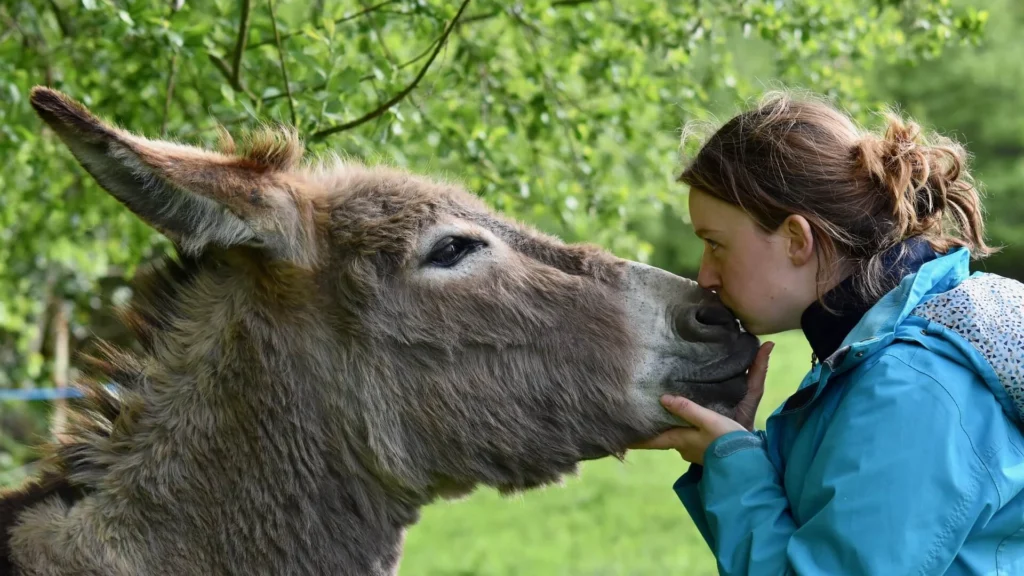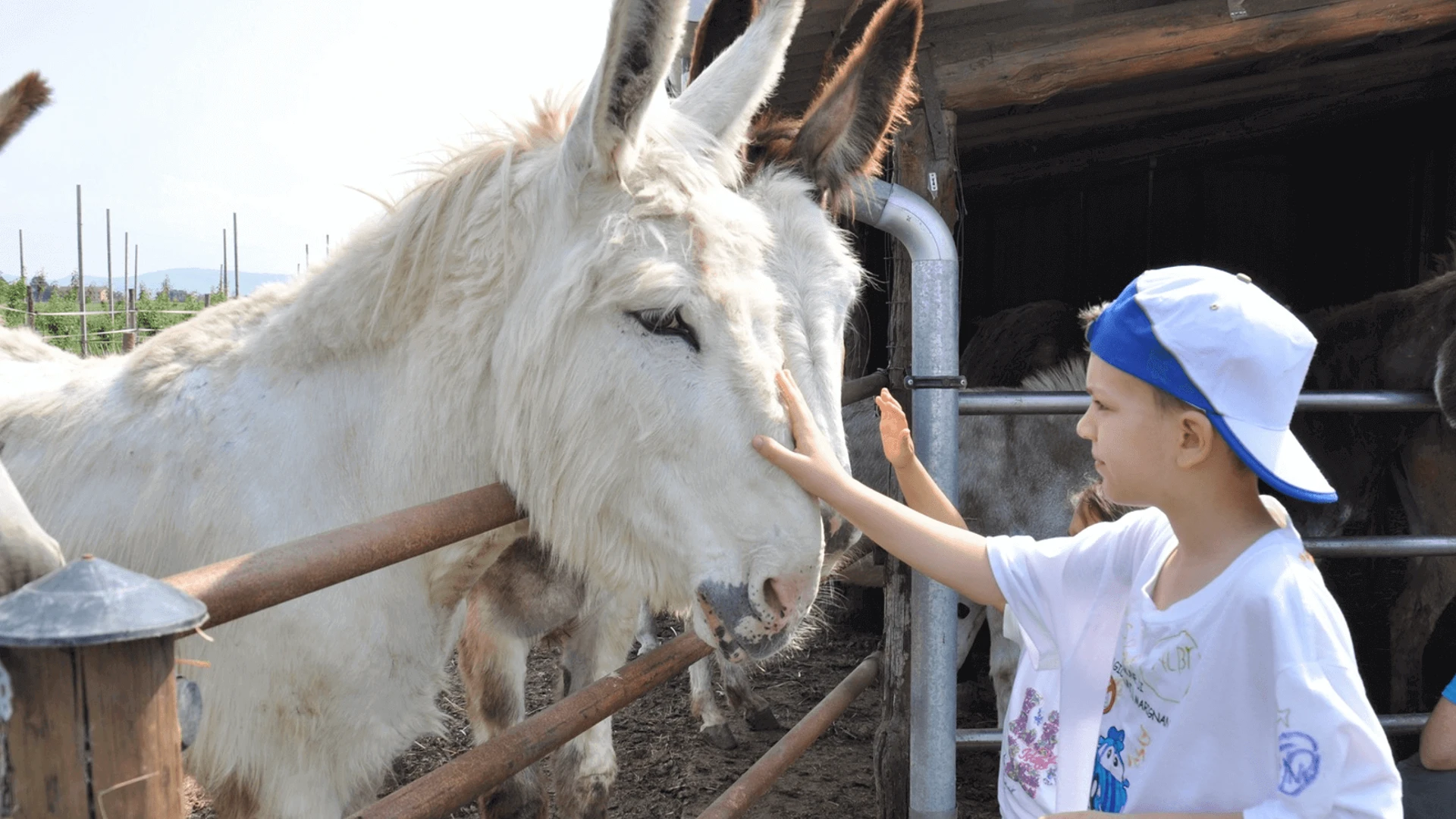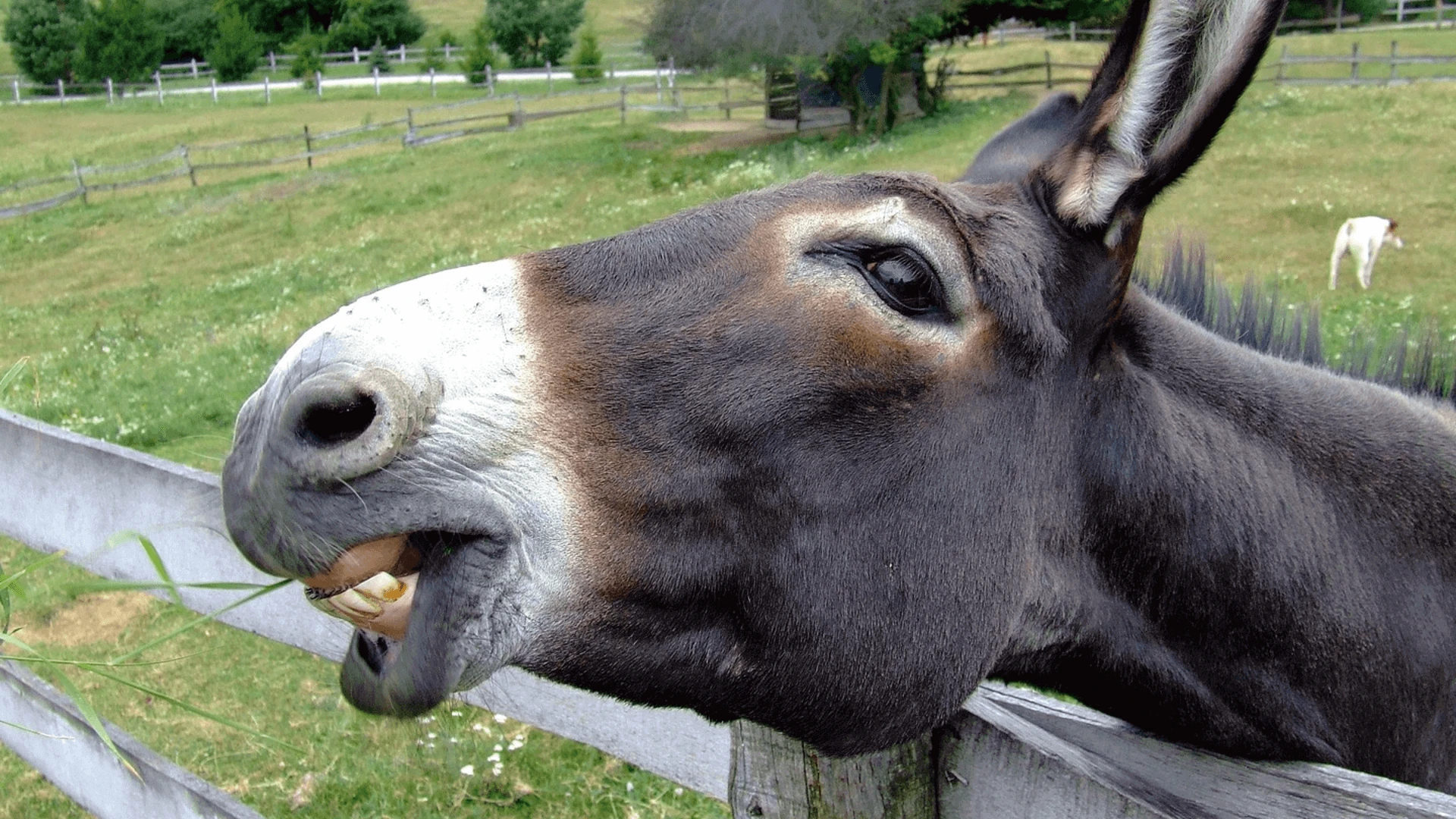A long-circulated yet unsubstantiated statistic claims that more people are killed by donkeys each year than by plane crashes. While that’s unlikely, a donkey can deliver a deadly blow with its hind legs.
How do you approach a donkey so it doesn’t kick you? Start in front of the donkey, standing slightly to one side so that he can see you clearly. Avoid looking the donkey directly in the eye as this could be interpreted as a sign of aggression. Speak quietly and calmly as you approach. Approach the donkey slowly and watch his body language for positive signals. If he turns towards you with his ears pricked and his body relaxed, it’s safe to approach.
Never approach a donkey from behind. Donkeys have a blind spot directly behind their heads, meaning they can’t see you coming if you’re behind them. In this situation, a donkey may perceive you as a potential predator and, using his inbuilt flight/fight mechanism, will either flee or attack with his powerful hind legs.
Kicking Plays An Important Role In Donkey Survival
Kicking is a natural part of a donkey’s behavior. They use their powerful hindquarters to protect themselves against potential predators. They also use it to defend their territory. Male donkeys show extreme aggression towards one another if there’s a young Jenny in heat. They bite and kick one another until the weaker jack submits.
Donkeys also bray, pin their ears back, swish their tails, and paw at the ground to express their discomfort. If the potential predator or aggressor doesn’t respond to these signals, the donkey will increase his aggression until it does. That can include charging at them, biting, kicking, and trampling.
Donkeys may also kick in pain. If you’re handling a donkey and he kicks out when you try to lift one of his hooves, it’s probably pain-related rather than aggressive behavior. Rather than threatening you, he’s trying to avoid the pain he experiences when he lifts his foot.
Arthritis and back problems can both lead to pain-related kicking.
How to Befriend a Donkey
A donkey’s vision and his instinctive behavior both dictate how he responds to a human. While they have good peripheral vision, they have comparatively poor eyesight directly in front and behind them. If you want to befriend a donkey safely, you should avoid both those areas.
When you approach a donkey for the first time, do so from a non-aggressive position. Stand in front of the donkey but with your shoulder towards him. This is a non-confrontational position that allows the donkey to see you clearly while minimizing your profile.
Make sure the donkey has seen you before you approach him. If he’s uncomfortable with your presence or wants to be left alone, he will communicate this by:
- Walking away from you
- Pinning his ears down and back along his neck
- Braying in distress
- Stomping or pawing at the ground
- Flaring his nostrils or snorting
- Swishing his tail
If you see any of these signs, back away from the donkey and give him a little more time. A donkey will invite you into space by looking towards you with his ears up and relaxing his body.
Move towards the donkey’s shoulder, speaking quietly to get his attention and moving slowly. This ensures the donkey knows where you are at all times. Stay relaxed and breathe slowly to show that you’re not a threat.
The Best Places to Pet a Donkey
When you approach a donkey, head towards his shoulder. Touch him gently on the neck and shoulder. Watch his body language for signs of affection. If he starts displaying any signs of discomfort, move your hand away and give him time to process the interaction. Once he starts to relax, stroke him on the neck before proceeding over the shoulder and along the back.
Donkeys don’t only kick backward but also to the side. To safely handle a donkey, therefore, you need to leave ample space around his hindquarters. If you do need to enter this zone, make sure the donkey is aware of your presence. Staying close to the donkey will keep you out of the danger zone and prevent him from being able to give you a full-powered kick.
If your donkey lifts his hind legs or paws the ground, move back towards his shoulder and return to stroking his neck and shoulder until he stops moving.
A donkey may be comfortable with you stroking his neck but inclined to use his natural defenses to protect his sensitive undercarriage. If you do need to touch a donkey on his stomach or between his back legs, do so gradually and carefully.
Keep an eye on your donkey’s ears and watch for any signs of discomfort or aggression. Talk quietly to your donkey throughout, reassuring him that you mean him no harm.
The Power of a Donkey’s Kick
I couldn’t find any studies on how hard donkeys kick. I did discover that the speed of a horse’s kick is around 220 mph and carries approximately 2,000 pounds of destructive force. A kick that powerful could easily kill you if it connected with your head, chest, or stomach.
Donkeys are smaller than horses which probably makes their kicks less powerful. On the other hand, the donkey’s hoof is more compact, increasing the amount of force it delivers per square inch. If you need proof of how dangerous a donkey’s kick can be, look no further.
In 2012, William Bohlke, a 65-year-old Californian man, died after being attacked by a pair of donkeys. The autopsy found a blunt trauma to the chest to be the cause of death.
Over a hundred years before that, the Ann Arbour Courier reported that a donkey jack killed a 750-lb grizzly bear, fracturing his shoulder and smashing his jaw and ribs.
Conclusion
Most people survive a kick from a donkey, but it’s never a pleasant experience. To avoid getting kicked, approach a donkey from the front so he can see you clearly. Never move towards a donkey from the rear. He has powerful hindquarters to protect himself against predators, and he won’t hesitate to use them if he feels threatened.
My Favorite Equine Resources For Horses and Donkeys
This list contains affiliate products. Affiliate products do not cost more but helps to support BestFarmAnimals and our goal to provide farm animal owners with accurate and helpful information.
Squeaky Chicken Toy is hilarious to watch and the horses love it! It’s not super tough so keep it away from dogs.
Dewormer with Ivermectin: I use this for my horses and my goats. Duvet makes a great dewormer. I switch between the Ivermectin one and one like this one so the worms don’t get immune to it.
Manna Pro Apple Flavored Nuggets are a delicious smelling treat that my horses go crazy over.
Equinity Amino Acid Supplement for Horses makes a big difference for any horse that’s struggling with arthritis, hoof issues, or just generally. It’s great for older horses who can’t absorb all the nutrients in their food as well!
Manna Pro Weight Accelerator helps older horses gain weight and stay healthier! This was especially helpful when one of my older horses lost weight over the winter and helped her regain her weight over the summer!
Farnam Fly Control goes on the horse or donkey and will keep the flies off your sweet pet. It makes horses way more comfortable and will keep sores from getting infected as well.
Wound Kote protects sores and wounds. It acts as an antiseptic and helps wounds heal faster. It works on both my horses and goats.



